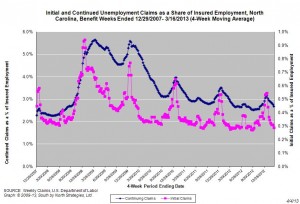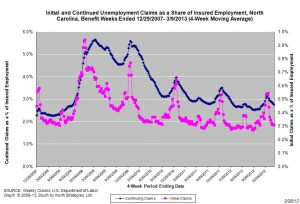04.04.2013
Policy Points
For the benefit week ending on March 16, 2013, some 9,989 North Carolinians filed initial claims for state unemployment insurance benefits and 96,600 individuals applied for state-funded continuing benefits. Compared to the prior week, there were fewer initial and fewer continuing claims. These figures come from data released by the US Department of Labor.
Averaging new and continuing claims over a four-week period — a process that helps adjust for seasonal fluctuations and better illustrates trends — shows that an average of 11,002 initial claims were filed over the previous four weeks, along with an average of 101,767 continuing claims. Compared to the previous four-week period, the average number of initial claims was lower, as was the average number of continuing claims.
One year ago, the four-week average for initial claims stood at 11,354, and the four-week average of continuing claims equaled 113,785.
In recent months covered employment has increased and now exceeds the level recorded a year ago (3.8 million versus 3.7 million). Nevertheless, there are still fewer covered workers than there were in January 2008, which means that payrolls are smaller today than they were approximately five years ago.
The graph shows the changes in unemployment insurance claims measured as a share of covered employment in North Carolina since the recession’s start in December 2007. 
Both new and continuing claims appear to have peaked for this cycle, and the four-week averages of new and continuing claims have fallen considerably. Yet continuing claims remain at an elevated level, which suggests that unemployed individuals are finding it difficult to find new positions.
29.03.2013
Policy Points
Policy Points is taking a few days off to celebrate the Easter holiday. Regular posting will resume on April 2, 2013.
Thank you for your interest in the blog.
28.03.2013
News Releases, Policy Points
CHAPEL HILL, NC (March 28, 2013) – In February, employers in North Carolina added 3,300 more payroll positions than they eliminated (+0.1 percent). While the statewide unemployment rate (seasonally adjusted) fell by 0.1 percentage points in February, the decline was attributable to a contraction in the size of the labor force; in fact, fewer people held jobs in February than in January. These findings come from new data released by the Labor and Economic Analysis Division of the NC Department of Commerce.
“Payroll employment growth in North Carolina slowed to a virtual standstill in February,” said John Quinterno, a principal with South by North Strategies, Ltd., a research firm specializing in economic and social policy. “Despite logging seven straight months of employment growth, North Carolina still has fewer jobs than it did in December 2007. Compared to then, payroll levels are lower in seven of the state’s ten major private industrial supersectors.”
In February, North Carolina employers added 3,300 more jobs than they cut (+0.1 percent). Private-sector payrolls netted 2,200 positions (+0.1 percent), while public-sector payrolls gained 1,100 jobs (+0.2 percent). Within the private sector, the professional and business services sector netted the most jobs (+2,600, +0.5 percent), with virtually all of the gain originating in the professional, scientific, and technical services subsector. The education and health services sector added, on net, 2,100 jobs (+0.4 percent), with health care and social services sector responsible for 66.7 percent of the gain. Meanwhile, the leisure and hospitality services sector shed the most positions (-3,000, -0.7 percent), with 83.3 percent of the losses occurring in the accommodations and food services subsector. The trade, transportation, and utilities sector lost 1,500 positions (-0.2 percent), followed by the other services sector (-600, -0.4 percent).
A revision to the January payroll data found that the state gained slightly fewer jobs than first estimated (+14,100 versus +15,100). With that revision, North Carolina now has, on net, 118,300 fewer payroll positions (-2.8 percent) than it did in December 2007. Since bottoming out in February 2010, the state has netted an average of 5,819 payroll jobs per month, resulting in a cumulative gain of 209,500 positions (+5.5 percent).
“The past few months have seen relatively better job growth in North Carolina, and as a result, the state has recovered some of the ground lost during the recession,” noted Quinterno. “The pace of growth, however, remains subdued, and the state still has fewer jobs than it did at the start of latest recession despite being three years into a recovery.”
The household data for February also pointed to the existence of a lackluster labor market. Last month, the number of unemployed North Carolinians fell (-6,585, -1.5 percent), but so did the number of employed persons (-4,964, -0.1 percent). The slight drop in the unemployment rate to 9.4 percent from 9.5 percent in January therefore was a product of a contraction in the size of the labor force (-11,549, -0.2 percent). In February, the share of the working-age population participating in the labor force (63.2 percent) fell after having risen in each of the prior five months.
Compared to a year ago, some 63,847 more North Carolinians held jobs in February (+1.5 percent), while 997 more persons were unemployed (+0.2 percent). Nevertheless, the unemployment rate fell by 0.1 percentage points due to the overall increase in the size of the labor force. Additionally, both the labor force participation rate and employment to population ratio increased by 0.2 percentage points over the year, though both measures remain at depressed levels.
The growth in the labor market that has occurred over the past year, however, is weak in relation to the severity of the employment problems facing the state. North Carolina’s unemployment rate has equaled or exceeded 9 percent in every month since January 2009 and has ranged as high as 11.4 percent. Over the past 14 months, the rate has fluctuated between 9.4 percent and 9.6 percent. Moreover, compared to December 2007, which was when the “Great Recession” began, the statewide unemployment rate is 4.4 percentage points higher, and the number of unemployed North Carolinians is 95.4 percent larger.
“The February employment was a fairly unimpressive one that points to a labor market that is stable but not necessarily improving in ways perceptible to the almost 447,000 North Carolinians who are jobless and seeking work,” observed Quinterno. “The bottom line is that North Carolina continues to face a sizable jobs shortfall, slow payroll growth, and widespread unemployment. In all those respects, 2013 so far is proving no different than 2012.”
28.03.2013
Policy Points
For the benefit week ending on March 9, 2013, some 10,492 North Carolinians filed initial claims for state unemployment insurance benefits and 99,872 individuals applied for state-funded continuing benefits. Compared to the prior week, there were fewer initial and fewer continuing claims. These figures come from data released by the US Department of Labor.
Averaging new and continuing claims over a four-week period — a process that helps adjust for seasonal fluctuations and better illustrates trends — shows that an average of 11,716 initial claims were filed over the previous four weeks, along with an average of 104,733 continuing claims. Compared to the previous four-week period, the average number of initial claims was lower, as was the average number of continuing claims.
One year ago, the four-week average for initial claims stood at 11,739, and the four-week average of continuing claims equaled 116,323.
In recent months covered employment has increased and now exceeds the level recorded a year ago (3.8 million versus 3.7 million). Nevertheless, there are still fewer covered workers than there were in January 2008, which means that payrolls are smaller today than they were approximately five years ago.
The graph shows the changes in unemployment insurance claims measured as a share of covered employment in North Carolina since the recession’s start in December 2007. 
Both new and continuing claims appear to have peaked for this cycle, and the four-week averages of new and continuing claims have fallen considerably. Yet continuing claims remain at an elevated level, which suggests that unemployed individuals are finding it difficult to find new positions.



 Email Sign-Up
Email Sign-Up RSS Feed
RSS Feed